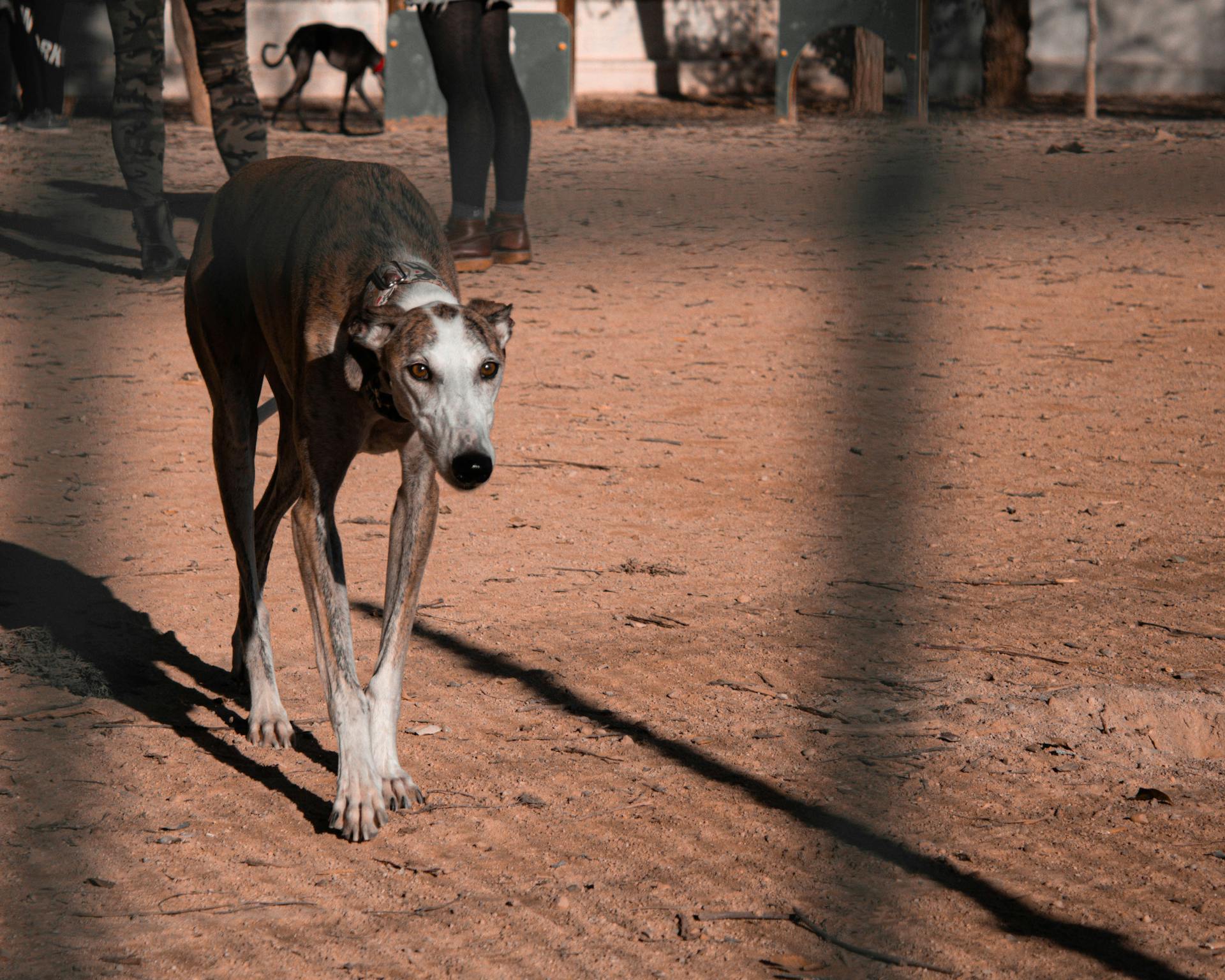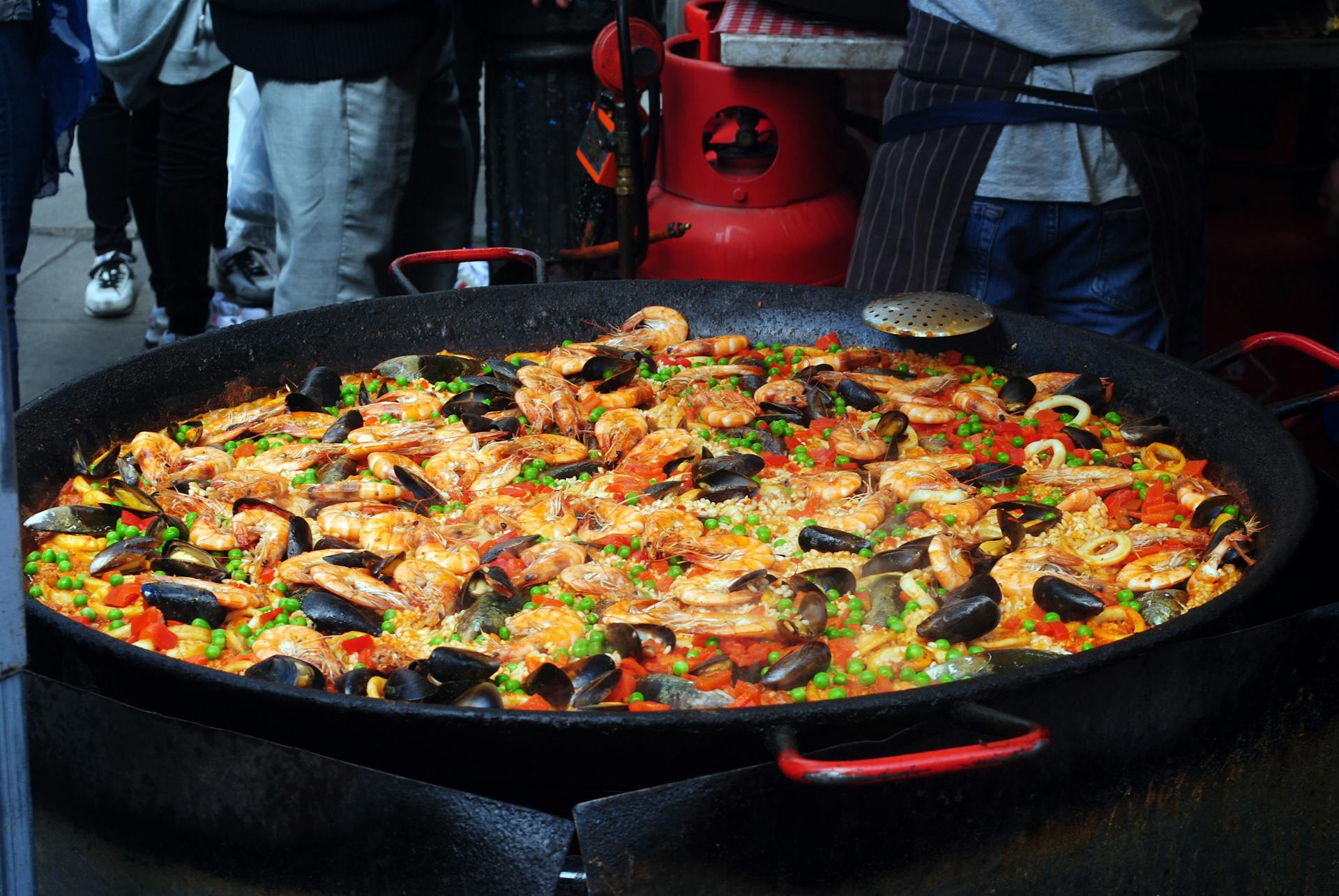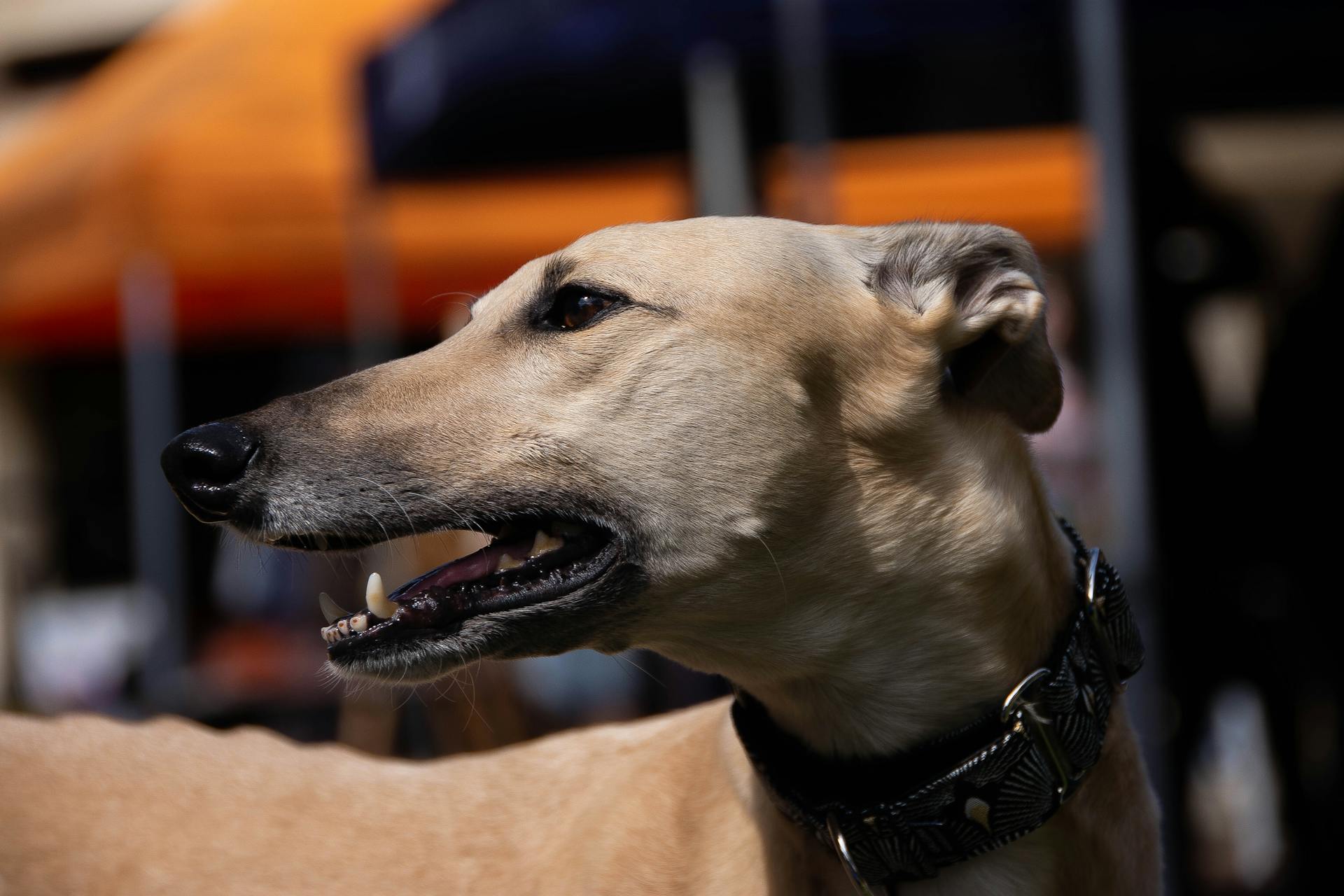
The Spanish Greyhound is a sleek and agile breed that's perfect for active owners who love the outdoors. They're a rare sight, but well worth getting to know.
Originally bred in Spain over 2,000 years ago, this ancient breed was used for hunting small game and companionship. They're a testament to the region's rich history and cultural heritage.
With their slender build and short coats, Spanish Greyhounds are built for speed and agility. They're a relatively small breed, weighing in at around 25-35 pounds.
Their short coats come in a variety of colors, including fawn, brindle, and white. They're relatively low-maintenance when it comes to grooming, making them a great choice for busy owners.
Recommended read: Short Hair Guard Dogs
Origins and History
The Spanish Greyhound, also known as the Galgo, has a fascinating history that spans thousands of years.
Its name is thought to be a contraction of the word "gallicus", suggesting a possible Gallic or Celtic origin, but this theory is disputed.
The breed was already known in Roman times, and its true origins remain unclear, with some theories suggesting it descended from Eastern Greyhounds that arrived in Spain from Africa.
Many historians believe the Celts acquired sighthounds from Phoenician merchants, and later, the Moors conquered Spain and brought African sighthounds, which may have been bred with the Galgo.
The Spanish Greyhound was originally owned by the noble class and was highly esteemed for its hunting abilities.
However, the lower classes began stealing these dogs and breeding them indiscriminately, leading to a decline in their favor among the nobles.
Today, the Spanish Greyhound is rarely found outside of its native Spain, and many dog clubs do not recognize the breed.
FCI Classification
The FCI classification of the Spanish Greyhound is quite interesting. They are classified as a very cold, detached and haughty breed when it comes to strangers.
As you interact with a Spanish Greyhound, you'll notice they make it clear that their presence isn't welcome to outsiders.
Characteristics
The Spanish Greyhound is a calm and gentle dog, known for their reserved nature. They are often described as serious, but they show great affection towards their owners.
These dogs aren't very playful with children, and they prefer activities like trailing or tracking that require concentration and discipline. However, they can become very energetic if they see something to chase.
The Galgo generally has a laid-back personality and is friendly with people, including children. They typically get along with other dogs and sometimes cats, but they might view smaller animals as prey.
Here's a summary of the Spanish Greyhound's temperament and characteristics:
Characteristics of the
The Spanish Greyhound is a unique breed that's often misunderstood. They're typically reserved and serious, but with their owners, they show great affection.
One thing to note is that they're not very playful with children, so it's essential to consider this before bringing one home. They do enjoy playful and stimulating activities like trailing or tracking, though.
Spanish Greyhounds are calm, poised, and gentle, which makes them a great companion for those who value a quiet life. However, they can become very energetic if they see something to chase while out and about.
These dogs are bred to hunt hares and other small game, but they can be badly treated if they're not used for hunting. This is a significant problem in Spain, where they're only bred for hunting.
A key characteristic of the Spanish Greyhound is their independence. While they can be quiet and keep to themselves, they thrive when stimulated and interacted with kind people. They're not aggressive, but they do tend to keep their distance from guests.
Here's a breakdown of their temperament:
Overall, the Spanish Greyhound is a loyal and loving companion for those who understand their needs and provide the right environment.
Breed Appearance
The Spanish Greyhound and Galgo breeds are both known for their athletic build, with the Spanish Greyhound standing between 24 and 27 inches tall at the withers, and the Galgo being slightly smaller.
For more insights, see: Spanish Greyhound vs Greyhound

Their lean, muscular bodies are well-suited for running, with the Spanish Greyhound having a slightly arched back and the Galgo being higher in the rear than in the front.
Both breeds have long, thin legs and triangular ears, with the Spanish Greyhound's ears having a wider base and a rounded tip, and the Galgo's ears giving the impression of being larger.
Their eyes are almond-shaped and somewhat small, with the Spanish Greyhound's eyes being usually dark but can be a lighter amber color if their coat color is lighter.
The Spanish Greyhound has a black nose and pigmentation on their eye rims and lips, while the Galgo comes in a variety of colors and coat patterns, including barcino, negro, and barquillo.
Their coats can be either smooth or rough, with the rough coat providing extra protection from skin injuries for the Galgo.
The Spanish Greyhound's coat colors include toasted cinnamon, yellow, white, red, dark brindle, and pied, while the Galgo's colors include barcino, negro, barquillo, and tostado.
Both breeds have a streamlined head, with the Galgo's head being particularly long and giving the impression of larger ears.
Recommended read: Greyhound Dog Colors
Behaviour
The Spanish Greyhound is a calm and quiet breed, but they can become bored if left alone for too long. They need a good run around before and after being left alone to prevent boredom.
They are reserved and don't generally bark, which is a great trait for a quiet home. However, they can jump very high, so a secure enclosure is essential if you live in the countryside.
The Galgo's hunting instinct and speed make them prone to running away if they spot something interesting. This means keeping a close eye on them when they're outside.
Despite their independent nature, the Spanish Greyhound is happy to sleep the day away on their backs on a sofa. They're also happy to get by with what they have, not being greedy or demanding.
However, they can be wary of strangers and may ignore them completely, making them poor guard dogs. They'd rather find a safe spot to wait for the stranger to leave than raise the alarm.
Early socialization is crucial to prevent them from becoming overly shy or developing separation anxiety. With proper training and care, they can thrive in a loving home.
Lifestyle

Spanish Greyhounds can happily live inside due to their calm temperament, but they still need to burn off their energy every day in large and open spaces.
They require regular walks, ideally several times a day, especially if they live in an apartment, as their liveliness and predatory instinct can make walking in complete freedom difficult.
Living in a house with a garden can be suitable, but they still need large spaces to run around and exercise.
Walking them off the lead should only be done in a secure environment free of any temptations, as their instinct can lead them astray.
Sports activities specifically designed for dogs are encouraged, as they stimulate their sense of smell and keep them engaged.
Their great size can sometimes restrict travelling, especially in public transport, but with intelligent training and socialization, they can accompany their owners wherever they go.
Related reading: Large Bully Breeds
Health and Nutrition
Galgos are a relatively healthy breed, but they do have some specific needs to stay that way.
Their history as a working sighthound has helped prevent hip dysplasia, a common issue in many breeds.
Regular exercise is crucial, as Galgos need to run or walk long distances to stay in top shape. They're built for speed, not for lounging around all day.
To keep your Galgo healthy, make sure to feed a high-quality, nutritionally balanced diet.
Fresh water should always be available, and you should discuss the best diet and feeding schedule with your vet.
It's typical to feed two measured meals per day, but be aware that Galgos can be prone to bloat and stomach twisting if they eat too quickly.
To prevent this, you can try feeding smaller, more frequent meals or using a special feeder that slows down their eating.
Common Health Problems
As a Galgos owner, it's essential to be aware of the potential health issues that can affect your furry friend. Galgos are generally a healthy breed, but they can be prone to certain problems.

Their light weight and anatomy discourage hip dysplasia, which is a common issue in larger breeds. This is a huge relief for Galgos owners, as it means fewer joint problems and a longer, healthier life.
However, Galgos can be sensitive to anesthesia, so it's crucial to inform your veterinarian about this issue before any surgery or procedure. This will ensure that your dog receives the best care possible.
Regular exercise is also vital for Galgos, as they need to run and/or walk long distances to stay in perfect health. This means owners need to make time for daily exercise with their Galgos.
Here are some common health problems that can affect Galgos:
- Osteosarcoma, a type of bone cancer
- Bloat and gastric torsion, which can be life-threatening
- Anesthesia sensitivity, as mentioned earlier
- Heart problems, which can be caused by their athletic nature
- Eye problems, which can be a result of their sighthound heritage
Diet and Nutrition
When feeding your Galgo, it's essential to have fresh water available at all times. You should discuss the type of diet and amount with your vet to ensure it's nutritionally balanced.
A high-quality canine diet is a must for your Galgo's overall health. Feed your Galgo two measured meals per day, as this is typical for their needs.

However, Galgos can be prone to bloat and stomach twisting if they eat too quickly. This is why it's crucial to slow down their eating.
You might want to consider feeding smaller, more frequent meals or using a special feeder that slows down their eating. This can help prevent potential life-threatening stomach twisting.
Avoid exercising your dog right before and after a meal, as this can put extra pressure on their digestive system.
Shedding
Shedding is a breeze with the Spanish Greyhound, as they only lose a moderate amount of hair due to their short coat.
Their unique coat type is also responsible for minimal molting, as they don't have an undercoat that sheds heavily.
This means you can enjoy a relatively hair-free home with a Spanish Greyhound, making them a great choice for those with allergies or a preference for low-maintenance grooming.
A fresh viewpoint: Flat Coat Doodle
Frequently Asked Questions
What is the difference between a Greyhound and a Spanish Greyhound?
What's the main difference between a Greyhound and a Spanish Greyhound? A Spanish Greyhound, also known as a Galgo, is smaller, lighter, and has a more streamlined head and longer tail compared to a Greyhound.
What are Spanish greyhounds called?
The Galgo Español is also known as the Spanish Greyhound, a name that can be misleading due to its distinct lineage from the English/Irish Greyhound.
What is the difference between a galgo and a Greyhound?
Galgos are smaller, lighter, and have a more streamlined head than Greyhounds, with a flatter build and longer tail. This distinct physique reflects their endurance running ability, setting them apart from the Greyhound breed.
What happens to Galgos in Spain?
Unfortunately, many Galgos in Spain are euthanized in inhumane ways at the end of the hunting season, including hanging, shooting, and burning. This cruel fate highlights the urgent need for improved animal welfare and protection in Spain.
What is the life expectancy of a galgo?
The average life expectancy of a galgo is 12-15 years. With proper care, these loving companions can bring joy to families for many happy years.
Featured Images: pexels.com


